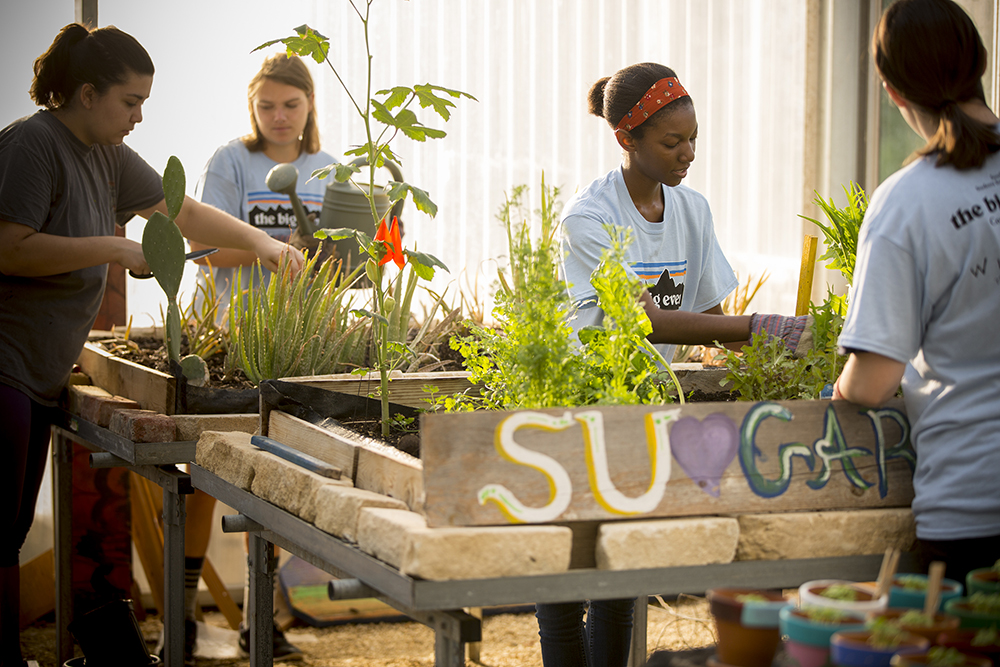News
Sustainability Begins with “SU”
Evidence of the school’s eco-minded efforts are visible in every corner of campus, from the solar panels on Heather Hall to the water bottle refill stations, rainwater collection barrels, single stream recycling, and much more.
October 09, 2017
October 09, 2017
Open gallery

Taking a stroll through the Southwestern campus, passing by its historic buildings and tree-filled lawns, one can almost pretend that nothing has changed since the school’s founding over 175 years ago. But let’s take a closer look. The idyllic lampposts dotting the sidewalks are outfitted with LED bulbs and powered solely by renewable energy. The high-pitched twittering of Chimney Swifts comes from a student-maintained tower habitat near the campus garden. Evidence of the school’s eco-minded efforts are visible in every corner of campus, from the solar panels on Heather Hall to the water bottle refill stations, rainwater collection barrels, single stream recycling, and much more.
Since its transition to 100% wind power in 2010, Southwestern University has continued to expand its sustainability initiatives at an impressive rate. In 2015, the Princeton Review ranked SU among the top environmentally responsible colleges. A year later, the EPA recognized the school as a Green Power Champion for using more green power than any other school in the Southern Collegiate Athletic Conference. Whether it’s switching to low flow toilets and shower heads or adopting a Meatless Monday policy in the commons, the push for sustainability isn’t just coming from the University’s faculty and staff, but also from its students. Professor Joshua Long, who joined Southwestern in 2011 as the Environmental Studies Program’s first full time faculty member, says he has been amazed by his students’ creativity and determination.
“What I love about my job is that I am hardly ever the person with the idea. It’s almost always the students who come to me with ideas for improving campus sustainability,” says Long. He points to the green fund legislation the students passed in 2013 as evidence. By creating a sustainability fund, students are able to apply for financial support to bring new initiatives to life.
Southwestern University places a strong emphasis on learning by doing and its relatively new Environmental Studies Program has followed suit. In 2014, it was decided that the program’s capstone class would be focused on group projects that in some way further sustainability on campus. Also, a 25-acre eco lab for soil and water sampling as well as wildlife monitoring was recently created from a tract of previously unused university land. Students participated in cleaning up the area and setting up trail cameras to monitor the lab’s biodiversity. Since then, they have gathered footage of coyotes, deer, a wild turkey, bobcats, foxes, even a river otter. By digitizing historic photos of the land, and creating an overlay within the program’s Geographic Information System (GIS), the students were able to study the ecological history of the lab and see how its landscape has changed over time.
This coming together of history and ecology is typical of Southwestern’s interdisciplinary approach. On the current Environmental Studies committee are faculty from a wide range of departments such as anthropology, biology, physics, economics, even theater and religion. According to Professor Long, teaching students to reach across disciplines is the best way to understand the larger picture of environmental impact. A key component of this picture being environmental justice, a required class but also a topic integrated throughout the major curriculum.
Long explains that “environmental services can be distributed equally or unequally. If you’re talking about wind energy, you don’t just think about the reduction of greenhouse gasses, but also the consequences to where you’re putting the turbines. Does building the turbines create pollution? Is that pollution affecting one community more than another? How do you spread the benefits and the burdens in the best way?”
Community consciousness is something Southwestern University has practiced for many years through its close ties to the city of Georgetown. In fact, it was a small wind power contract the city initiated in 2008 that made it possible for Southwestern to move to 100% renewable energy just two years later. SU’s experience with wind power helped the city better navigate its own transition to 100% renewable energy which happened this past April. Last Spring, Southwestern University and the city of Georgetown could be seen side by side at Earth Day Texas, twin examples of sustainability in action.
“We have the same goals as Southwestern,” says Georgetown’s mayor Dale Ross, who put partisan politics aside to make what he considers the best decision for the city. For Mayor Ross, the benefits are both environmental and economic. “If i came to you today and said you can buy gas for your car at $2.25 per gallon for the next 25 years, you would say absolutely.”
Unlike natural gas that offers—at most—a seven year contract, Georgetown’s wind contract locks in energy costs for the next 20-25 years. This makes budgeting easier for the city, and in turn, the University as well. The symbiosis goes both ways. In 2011, a student in the school’s GIS program mapped the solar radiation potential of the buildings on the SU campus. This research was then used by the city of Georgetown to optimize its own solar collection.
Examples like this, of student-led sustainability initiatives, are abundant at Southwestern University. Even the existence of the University’s robust Environmental Studies Program is partially owing to a student group called SEAK (Students for Environmental Activation and Knowledge) that lobbied for the program to be created back in 1999.
SU may be Texas’s oldest University, but its commitment to sustainability is very progressive. Far from competing with the University’s rich past, these ongoing ecological efforts ensure that Southwestern University will be around well into the future.














